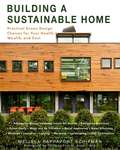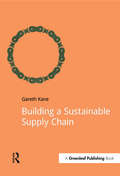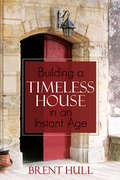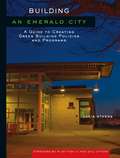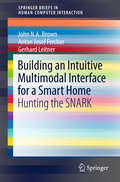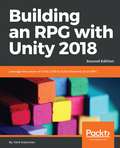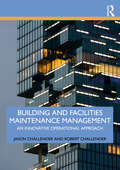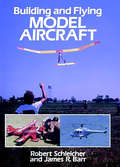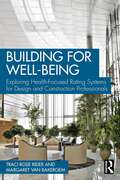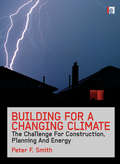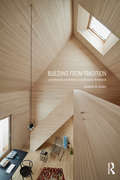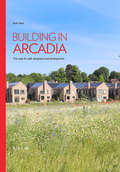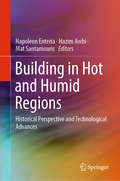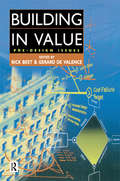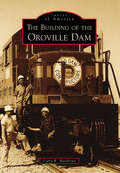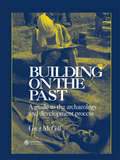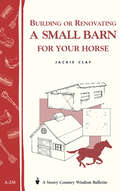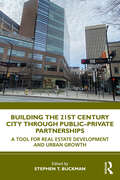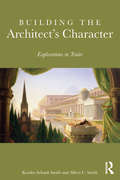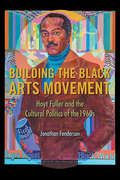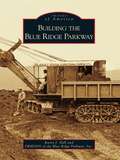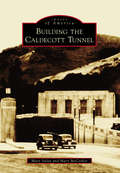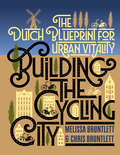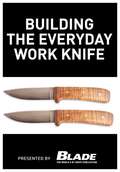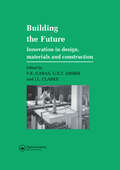- Table View
- List View
Building a Sustainable Home: Practical Green Design Choices for Your Health, Wealth, and Soul
by Schifman MelissaThe green building movement has produced hundreds of “how-to” books and websites that are filled with tips about green building and what homeowners should do to go green. While helpful and informative, when it comes to making actual purchasing and installation decisions, these books do not make it any easier for a homeowner to prioritize against a budget. The Sustainable Home serves this need, as it is written by a sustainability advisor and financial advisor who has personally directed the building and LEED certification of her own home. Here, she shares her knowledge and experience for others to use in their journey toward a greener way of living. Whether the reader is building a new home or doing a minor remodel, a homeowner needs a framework by which to guide their decisions. These decisions are based on values, and the author posits that there are really only three reasons to go green: For Our Health: By building more sustainably, we reduce our exposure to harmful chemicals and toxins. For Our Wealth: By building a more durable home and being more efficient with resources like water and electricity, we reduce our monthly utility bills and ongoing maintenance expenses. For Our Soul: Collectively doing the right thing for our planet does make a difference—and that is soul-nourishing. Learn the logistics of choosing windows, insulation, appliances, and lighting. Find out about FSC certified wood and about using reclaimed materials. Here is everything you need to make your home sustainable.
Building a Sustainable Supply Chain (Doshorts Ser.)
by Gareth KaneThe massive oil spill in the Gulf of Mexico in 2010 was not caused by BP, but by a contractor, yet BP got the blame. The toxic waste from the production of Apple products dumped in China in 2011 was not dumped by Apple, but by a supplier, yet Apple got the blame. The horsemeat found in beef burgers in 2013 was not added by Tesco, but by a supplier, yet Tesco got the blame. In all three cases, blame for the damage caused by suppliers floated up through the supply chain until it lodged with the big brand at the top. No longer can companies constrain their corporate responsibility within the factory fence, as that boundary is not recognized by outside observers. This situation is exacerbated by the fact that the majority of most organizations’ environmental footprint lies in their supply chain. This means that, to address the sustainability agenda in a meaningful way, they must tackle the impacts of their suppliers. Unfortunately this is a huge challenge as visibility and influence diminishes quickly as you start to work your way down through the layers of suppliers. This book gives a quick but comprehensive guide to the most effective techniques to help you proactively address environmental risks in the supply chain. It covers the following: the business case for a sustainable supply chain; supply chains and sustainability: the big picture; making supply chains sustainable: the fundamentals; basic techniques: the "hard yards" of green procurement; intermediate techniques: those requiring changes to operations and products/services; advanced techniques: changes to the business model and corporate philosophy.The book draws upon exclusive interviews with top sustainability practitioners along with the practical experiences of the author to provide real world examples at the cutting edge.
Building a Timeless House in an Instant Age
by Brent HullThe author of Traditional American Rooms examines the evolution of home construction, making a case against mass-produced homes.HISTORY®’s Lone Star Restoration star, Brent Hull is a master craftsman, and hands-on preservationist. Hull—a Foreword Reviews Book of the Year Finalist for architectural non-fiction—challenges us to consider the impact our decisions will have when building a house. What do our homes say about us? What stories are they telling? Are they declarations of integrity, beauty, and heritage? Or do they suggest we have lost our sense of value, craft, and harmony?Nationally recognized as an authority on historic design, architecturally correct moldings, and millwork, Hull is uniquely qualified to speak to the craft of building and art of design. In an age of “instant”‘ homes, how do we build something timeless that weaves a tale of character, values, history, and heart? The decisions we make for our homes are not inconsequential. What we build defines us. In fact, the contrast between the way we build today and how structures used to be built has become only more vivid. What happened to craft? What happened to the art of building? Our values and what we believe about life have changed as well. We have come to see houses as a tradable commodity. We live in a time that is obsessed with “what’s next?” We need to be careful of fooling ourselves into thinking that a bottom-line mentality is the best way to approach building a home. Now is the time to examine ourselves, our motives, and our hearts.Praise for Building a Timeless House in an Instant Age“Part call to action, part exploration of technique, the result is a persuasive and enjoyable reminder that our homes are reflections of ourselves . . . . A pleasing, educational look at traditional home construction.” —Kirkus Reviews
Building an Emerald City: A Guide to Creating Green Building Policies and Programs
by Lucia AthensIn 2000, Seattle, Washington, became the first U.S. city to officially adopt the U.S. Green Building Council's LEED (Leadership in Energy and Environmental Design) "Silver" standards for its own major construction projects. In the midst of a municipal building boom, it set new targets for building and remodeling to LEED guidelines. Its first LEED certified project, the Seattle Justice Center, was completed in 2002. The city is now home to one of the highest concentrations of LEED buildings in the world. Building an Emerald City is the story of how Seattle transformed itself into a leader in sustainable "green" building, written by one of the principal figures in that transformation. It is both a personal account--filled with the experiences and insights of an insider--and a guide for anyone who wants to bring about similar changes in any city. It includes "best practice" models from municipalities across the nation, supplemented by the contributions of "guest authors" who offer stories and tips from their own experiences in other cities. Intended as a "roadmap" for policy makers, public officials and representatives, large-scale builders and land developers, and green advocates of every stripe, Building an Emerald City is that rare book--one that is both inspirational and practical.
Building an Intuitive Multimodal Interface for a Smart Home: Hunting the SNARK (Human–Computer Interaction Series)
by Gerhard Leitner John N.A Brown Anton Josef FercherThis book describes an innovative approach to the interaction between humans and a smart environment; an attempt to get a smart home to understand intuitive, multi-modal, human-centred communication. State of the art smart homes, like other "smart" technology, tend to demand that the human user must adapt herself to the needs of the system. The hunt for a truly user-centred, truly intuitive system has long proven to be beyond the grasp of current technology. When humans speak with one another, we are multimodal. Our speech is supplemented with gestures, which serve as a parallel stream of information, reinforcing the meaning of our words. Drawing on well-established protocols in engineering and psychology, and with no small amount of inspiration from a particular nonsense poem, we have successfully concluded that hunt. This book describes the efforts, undertaken over several years, to design, implement, and test a model of interaction that allows untrained individuals to intuitively control a complex series of networked and embedded systems. The theoretical concepts are supported by a series of experimental studies, showing the advantages of the novel approach, and pointing towards future work that would facilitate the deployment of this concept in the real world.
Building an RPG with Unity 2018: Leverage the power of Unity 2018 to build elements of an RPG., 2nd Edition
by Vahé KaramianBuild a high-end, multiplayer role-playing game (RPG) from scratch with C# and Unity 2018Key FeaturesGet insights into Unity's user interface (UI) system and and build UIs for your RPGImplement artificial intelligence (AI) to build intelligent entities that take your game to the next levelDevelop multiplayer features for an RPG using Unity 2018Book DescriptionIn a role-playing game (RPG), users control a character, usually in the game's imaginary universe. Unity has become a top choice for developers looking to create these kinds of immersive RPGs.Building an RPG with Unity 2018, based on building some of the most common RPG features, teaches you tips, tricks, and techniques that can be applied to your own game.To start with, the book guides you through the fundamentals of role-playing games. You will learn the necessary aspects of building an RPG, such as structuring the game environment, customizing characters, controlling the camera, and designing other attributes such as inventory and weapons. You will also explore designing game levels by adding more features. Once you have understood the bigger picture, you will understand how to tackle the obstacles of networking in Unity and implement multiplayer mode for your RPG games.By the end of the book, you will be able to build upon the core RPG framework elements to create your own immersive games.What you will learnConstruct a framework for inventory, equipment, characters, enemies, quests, and game eventsUnderstand how to load and unload scenes and assetsCreate multiplayer game settings for your RPGDesign a UI for user input and feedbackImplement AI for non-character playersCustomize your character at runtimeWho this book is forBuilding an RPG with Unity 2018 is for you if you are a programmer interested in developing and further enhancing your skills when developing RPGs in Unity 2018. This book does not cover the basics of Unity, and so is for intermediate or more advanced users.
Building and Facilities Maintenance Management: An Innovative Operational Approach
by Jason Challender Robert ChallenderBuilding and Facilities Maintenance Management: An Innovative Operational Approach is a new introductory textbook aimed at students who are studying building maintenance and asset management for the first time as part of their undergraduate or foundation course. The book plugs a gap in the current curriculum and literature which must now seek to educate emerging professionals about the significance of the operational phase of a built asset’s lifecycle, if the challenges of the day are to be met head on.Each chapter is supported by seminar questions and formative assessment tasks to allow the learner to assess their own progress through the text and covers: The nature and importance of building maintenance for the successful strategic operation of an estate contracting and procurement of maintenance works risk assessment in maintenance management surveying for common maintenance issues and defects the relationship between maintenance management and environmental sustainability and maintenance and conservation of historic buildings The book will help readers enhance their awareness, understanding and breadth of knowledge of the issues around improving organisational maintenance management. A handy guide for emerging professionals, this practical book is also ideal reading for anyone studying facilities management, building surveying, construction management, real estate and property management.
Building and Flying Model Aircraft
by James R. Barr Robert SchleicherRichly illustrated manual introduces beginners to basic aerodynamic principles and all aspects of model-building -- from paint and tissue covering to the secrets of selecting the best engine, fuel, and radio-control rig for each plane.
Building for Well-Being: Exploring Health-Focused Rating Systems for Design and Construction Professionals
by Traci Rose Rider Margaret van BakergemBuilding for Well-Being is the first introduction to health-focused building standards for design and construction professionals. More than a summary of the state of the field, this practical resource guides designers, builders, developers, and owners through considerations for incorporating WELL®, Fitwel®, and other systems from the planning phase to ground-breaking and beyond. Side-by-side comparisons of established and emerging health-focused standards empower building professionals to select the most appropriate certifications for their projects. Drawing on the authors’ backgrounds in sustainable design and public health, chapters on the evolution of the green building movement and the relationship between health and the built environment provide vital context for understanding health-focused standards and certifications. The final chapter looks toward the future of health and the built environment.
Building for a Changing Climate: The Challenge for Construction, Planning and Energy
by Peter F. SmithThere is now a practically universal consensus that our climate is changing rapidly, and as a direct result of human activities. While there is extensive debate about what we can do to mitigate the damage we are causing, it is becoming increasingly clear that a large part of our resources will have to be directed towards adapting to new climatic conditions, with talk of survivability replacing sustainability as the new and most pressing priority. Nowhere is this more evident than in the built environment – the stage on which our most important interactions with climatic conditions are played out. In this frank yet pervasively positive book, sustainable architecture guru Peter Smith lays out his vision of how things are likely to change, and what those concerned with the planning, design and construction of the places we live and work can and must do to avert the worst impacts. Beginning with the background to the science and discussion of the widely feared graver risks not addressed by the politically driven IPCC reports, he moves on to examine the challenges we will face and to propose practical responses based on real world experiences and case studies taking in flood and severe weather protection, energy efficient retrofitting, distributed power generation and the potential for affordable zero carbon homes. He ends with a wider discussion of options for future energy provision. This will be a provocative, persuasive and – crucially – practical read for anyone concerned with the measures we must take now to ensure a climate-proofed future for humanity.
Building from Tradition: Local Materials and Methods in Contemporary Architecture
by Elizabeth M. GoldenBuilding from Tradition examines the recent resurgence of interest in the handmade building and the use of local and renewable materials in contemporary construction. In the past, raw materials were shaped to provide shelter and to accommodate the cultural, social, and economic needs of individuals and communities. This is still true today as architects, engineers, and builders turn once again to local resources and methods, not simply for constructing buildings, but also as a strategy for supporting social engagement, sustainable development, and cultural continuity. Building from Tradition features global case studies that allow readers to understand how building practices—developed and refined by previous generations—continue to be adapted to suit a broad range of cultural and environmental contexts. The book provides: • a survey of historical and technical information about geologic and plant-based materials such as: stone, earth, reed and grass, wood, and bamboo; • 24 detailed case studies examining the disadvantages and benefits to using traditional materials and methods and how they are currently being integrated with contemporary construction practices.
Building in Arcadia: The case for well-designed rural development
by Ruth ReedBuilding in Arcadia: The case for well-designed rural development is a reasoned, impassioned and ultimately practical book identifying key barriers to rural development, and how planning applicants (whether householders, developers and landowners), and most particularly their agents who make the applications – architects, landscape architects or planners – can address, and overcome, them. Focusing on the positive aesthetic role buildings can play in the landscape, and proposing sensitive development, Building in Arcadia also explores the essential economic, social and Environmental case for more building in the countryside to make the countryside more viable. In so doing, it will actively engage, challenge and provoke debate – as well as offering practical ways forward.
Building in Hot and Humid Regions: Historical Perspective and Technological Advances
by Napoleon Enteria Hazim Awbi Mat SantamourisThis book presents an in-depth analysis covering climatic and weather conditions, house and building development history, construction methods and technologies, and environmental conditions. It provides relevant house and building information and highlights recent advances in hot and humid regions, as well as developments in other regions that are relevant to hot and humid climates. The countries in hot and humid regions, which include the tropical countries, the Middle Eastern countries around the Mediterranean, and many countries of Central Asia and Africa, are home to some of the most challenging conditions in the world in terms of house and building design and construction, and in terms of maintaining indoor thermal comfort and air quality in an energy-efficient way. The book’s respective chapters, prepared by expert contributors, cover essential concepts, designs, and construction methodologies for houses and commercial buildings. As such, the book offers a valuable resource for undergraduate and graduate students in architecture and engineering, house and building designers, and building sciences researchers. Building contractors, manufacturers and distributors of building equipment and devices, and government policymakers and legislators will also benefit from the information provided in this book.
Building in Value: Pre-Design Issues
by Rick Best Gerard De ValenceThe concept of value in projects is a key issue for everyone involved in the construction industry. Building in Value brings together many experts in the field to outline the wide range of tools, techniques and procedures that can and should be used to make the building procurement phase as efficient as possible. The authors go on to discuss how to ensure that future problems in the design and construction of the buildings are anticipated at the start and to minimise the liklihood of future hiccups. Integrating strategic, financial and construction management techniques, this book provides an essential guide for construction professionals.
Building of the Oroville Dam, The
by Larry R. MatthewsIn the early 1960s, thousands of construction workers and their families came to Oroville, in Northern California, to help build the largest earth-fill dam in the world. Located nine miles northeast of town, the Oroville Dam would be the cornerstone of the California State Water Project, which would provide flood control, electric power, recreation, and water to California residents. The project was so massive that it would reinvent the look of much of the area; require the building of roads, bridges, and railroads; inundate much of the area's history under hundreds of feet of water; and greatly effect the lives of the residents of Oroville. The successful completion of the project came at a price--34 construction workers died.
Building on the Past: A Guide to the Archaeology and Development Process
by G. McGillThis comprehensive guide provides planners, developers, architects and archaeologists with an analysis of the conflicts between the archaeological development and planning processes. It takes a pragmatic approach to the effects of archaeology on development, enabling practitioners to reach practical solutions where archaeological considerations are taken into account in the development process.
Building or Renovating a Small Barn for Your Horse: Storey Country Wisdom Bulletin A-238 (Country Wisdom Bulletin Ser. #Vol. A-238)
by Jackie ClaySince 1973, Storey's Country Wisdom Bulletins have offered practical, hands-on instructions designed to help readers master dozens of country living skills quickly and easily. <P><P>There are now more than 170 titles in this series, and their remarkable popularity reflects the common desire of country and city dwellers alike to cultivate personal independence in everyday life.
Building the 21st Century City through Public-Private Partnerships: A Tool for Real Estate Development and Urban Growth
by Stephen T. BuckmanBuilding the 21st Century City through Public-Private Partnerships introduces students and early-career professionals to the fundamentals of this unique form of cross-sector collaboration. From understanding the responsibilities of government and industry partners to stewardship of taxpayer dollars, this introductory guide empowers developers and local officials to deliver successful commercial, leisure, and industrial projects neither could undertake on their own. Chapters on securing financing and navigating permitting processes demystify the steps to creating profitable developments, while case studies from around the United States provide invaluable local context. A glossary of public–private partnership terminology offers the reader an insider’s grasp of the language of government and industry partnerships. Equips developers and local officials with the foundations for successful collaboration Provides a template for building effective public–private partnerships in every area of real estate development Includes field-tested insights from case studies of diverse public–private partnership examples Ideal reading for courses in public administration, city planning, real estate, not-for-profit studies, public service, and more Helmed by a practitioner turned academic, Building the 21st Century City through Public–Private Partnerships serves as a masterclass with veteran developers, planners, municipal officials, and scholars.
Building the Architect's Character: Explorations in Traits
by Albert C. Smith Kendra Schank SmithAn understanding of architects’ character traits can offer important insights into how they design buildings. These traits include leadership skills necessary to coordinate a team, honest and ethical behavior, being well educated and possessing a life-long love of learning, flexibility, resourcefulness, and visionary and strategic thinking. Characteristics such as these describe a successful person. Architects also possess these traits, but they have additional skills specifically valuable for the profession. These will include the ability to question the use of digital media, new materials, processes, and methods to convey meaning in architectural form. Although not exhaustive, a discussion of such subjects as defining, imaging, persuading, and fabricating will reveal representational meaning useful for the development of an understanding of architects’ character. Through the analogies and metaphors found in Greek myth, the book describes the elusive, hard-to-define characteristics of architects to engage the dilemmas of a changing architectural landscape. Building the Architect’s Character: Explorations in Traits examines traditional and archetypal characteristics of the successful architect to ask if they remain relevant today.
Building the Black Arts Movement: Hoyt Fuller and the Cultural Politics of the 1960s (New Black Studies Series #104)
by Jonathan FendersonAs both an activist and the dynamic editor of Negro Digest, Hoyt W. Fuller stood at the nexus of the Black Arts Movement and the broader black cultural politics of his time. Jonathan Fenderson uses historical snapshots of Fuller's life and achievements to rethink the period and establish Fuller's important role in laying the foundation for the movement. In telling Fuller's story, Fenderson provides provocative new insights into the movement's international dimensions, the ways the movement took shape at the local level, the impact of race and other factors, and the challenges--corporate, political, and personal--that Fuller and others faced in trying to build black institutions. An innovative study that approaches the movement from a historical perspective, Building the Black Arts Movement is a much-needed reassessment of the trajectory of African American culture over two explosive decades.
Building the Blue Ridge Parkway (Images of America)
by Karen J. Hall FRIENDS of the Blue Ridge ParkwayThe Blue Ridge Parkway began as a dream in the late 1800s and became reality in 1983 when the 469-mile scenic highway was completed. Construction of the Blue Ridge Parkway began in September 1935 at Cumberland Knob. Heavy construction was done by contractors who won bids for the different projects along various sections of the parkway. Civilian Conservation Corps troops took care of the roadsides,landscaping, and structure building. As part of Franklin Roosevelt's New Deal, this project was intended to provide jobs throughout the region. Images of America: Building the Blue Ridge Parkway contains approximately 200 construction photographs of the Blue Ridge Parkway.
Building the Caldecott Tunnel
by Mary Mccosker Mary SolonToday, the Caldecott Tunnel connects Alameda and Contra Costa Counties, located in the San Francisco Bay Area. The original two bores of this tunnel opened in 1937, the same year as the San Francisco-Oakland Bay Bridge, and changed Contra Costa County from an area of small rural communities into one of growing suburbs. But this was not the first tunnel to connect these counties. The Kennedy Tunnel, opened in 1903, was accessed by steep and winding roads and located several hundred feet above today's tunnel. A third bore of the Caldecott Tunnel was opened in 1964 and a long-awaited fourth bore in late 2013. The tunnels have not been without disaster and tragedy over their hundred-plus years of existence, yet they remain an integral part of the commercial, social, and historic fabric of the region.
Building the Cycling City: The Dutch Blueprint for Urban Vitality
by Melissa Bruntlett Chris BruntlettThe world isrediscovering the bicycle as a multi-pronged solution to acute, 21st-century problems, including affordability, obesity, congestion, climate change, inequity, and social isolation. The Netherlands has built an accessible cycling culture that cities around the world can learn from.Chris and Melissa Bruntlett share the incredible success of the Netherlands through engaging interviews with local experts and stories of their own delightful experiences riding in five Dutch cities. Building the Cycling City examines the triumphs and challenges of the Dutch while also presenting stories of North American cities already implementing lessons from across the Atlantic. Discover how Dutch cities inspired Atlanta to look at its transit-bike connection in a new way and showed Seattle how to teach its residents to realize the freedom of biking, along with other encouraging examples.
Building the Everyday Work Knife
by Joe KertzmanAuthor of such books as Wayne Goddard's $50 Knife Shop and The Wonder of Knifemaking, Wayne Goddard takes you through his proven process of making the everyday working knife. Goddard speaks the language of ordinary people who like to use knives they've made themselves.
Building the Future: Innovation in design, materials and construction
by G. S. T. Armer J. L. Clarke F. K. GarasThis book forms the proceedings of the international seminar held by the Institution of Structural Engineers and the Building Research Establishment in Brighton in April 1993. It brings together contributions from 20 countries on recent innovations in building and construction.
